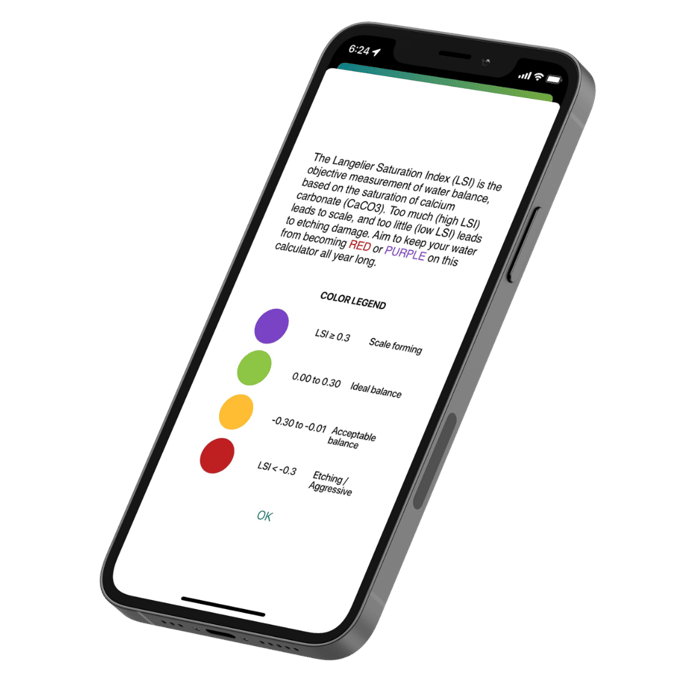Why does Orenda's advice often conflict with industry standards, textbooks and pool stores?
We at Orenda focus on obeying physics instead of trying to impose our will upon the water. We focus on the LSI, not range chemistry. That's why our advice differs from most other sources.
In short, almost every standard in the swimming pool industry is focused on disinfection with much less regard for balance. They are based on "range chemistry"; when in reality, water only cares returning to its natural state (as measured on the LSI).
By "range chemistry" we mean the textbook ranges for each parameter. You know, things like these:
- pH should be 7.2 - 7.8, ideally 7.4 - 7.6
- Total Alkalinity (TA) should be 80 - 120 ppm
- Calcium Hardness (CH) should be 200 - 400 ppm
- TDS should be no greater than 1500 ppm above tap water
The list goes on. And oftentimes, different sources have conflicting ranges. Some books say 7.2-7.6 pH, while others say 7.4-7.8. And is there any evidence to suggest that TDS is problematic at 1500 ppm over tap water? (Not that we know of).
In our opinion, all of these ranges teach us to focus on the wrong things, which forces us to miss the larger point. Water never read the textbooks. Water only cares about balance.
What water ACTUALLY cares about
Everything in nature seeks equilibrium. Balance. Water is no different.
We measure water balance using the Langelier Saturation Index (LSI). It tells us the saturation equilibrium of calcium carbonate (CaCO3). On the LSI, a value of 0.00 is perfectly balanced water, though you don't need to be perfect all the time. You just want your water between -0.30 and +0.30. On the Orenda Calculator®, we have color-coded LSI values, and you want your water to always be either green or yellow.

Without going too deep into the LSI (because it's our First Pillar of proactive pool care and you can learn more about it here, here and here), just know that the LSI is what water cares about. Not textbook ranges.
Yet industry standards and pool store software are based on those ranges, not the LSI. That's one place where Orenda's advice differs from the mainstream. And we don't find it contrarian at all. The way we see it, our advice is to take the laws of physics into account, whereas textbook ranges do not. And our advice consistently works because of that.
Where is your water going to be?
Another difference in our advice vs. everyone elses has to do with predicting the future. When you chase textbook ranges, your water is unpredictable. That's because you're forcing your will upon water, and water doesn't like that. It has to react to what you do in an effort to get back to equilibrium. But if you balance water according to what IT wants (LSI balance), water cannot fight you back. It has no reason to.
And while it's important to balance the water today, you also need to know where water is going to be when you come back. This takes an understanding of physics once again; this time with Henry's Law of the solubility of gases.

Your pH cannot be controlled by you, but it can be contained by physics. So we don't teach pool owners and operators to try and control pH, we teach you to contain it. Use physics to your advantage!
You can learn more about this concept here, and listen to these podcast episodes where we talk about this in-depth:
By utilizing the secondary readings on the Orenda Calculator®, you can see your pH ceiling. When you know how high your pH can naturally rise, all you need to do is make sure your LSI is balanced when the pH gets there. If the LSI is a green number at the pH ceiling, you have successfully contained pH, provided you do not over-correct with acid.
Be Proactive
"A prescription without diagnosis is malpractice" - Unknown
We believe reacting to problems is expensive and less effective than being proactive. That's why we created our Four Pillars program. The Four Pillars are the four most common denominators in pool problems we see. Just one simple action step for each one prevents over 90% of the problems we encounter from our customers on a daily basis. Here are the four action steps:
- Maintain LSI Balance year-round
- Supplement chlorine against the oxidant demand
- Maintain phosphate levels below 500 ppb (µg/L)
- Maintain CYA (stabilizer) levels at or below 50 ppm.
If you are proactive, less problems can start. You can decide to remove variables from your water to simplify your pool care. Our products help you do just that.
Diagnose problems before addressing them
And along that vein, you need to know what you're up against. Diagnosing issues is critical to successful pool care. That's why we have procedures like the white bucket test and podcast episodes like this:
Once you know for sure what you're up against, you can make an informed decision on how to resolve it.
Summary
Orenda advice differs from pool stores, textbooks and industry standards because we care more about what the water wants than what a textbook says it wants. We took the time to learn the physics at play, and embrace those laws of physics. We embrace things like Henry's Law as inevitable. We embrace the LSI because that's what water truly cares about. And we have built our calculator and education around keeping these things in harmony.
So don't dwell on individual factors of chemistry without looking at their role in the LSI first. They could be out of line, sure, but we care about that only within the context of LSI balance. And it works for us and our customers who follow our teachings.